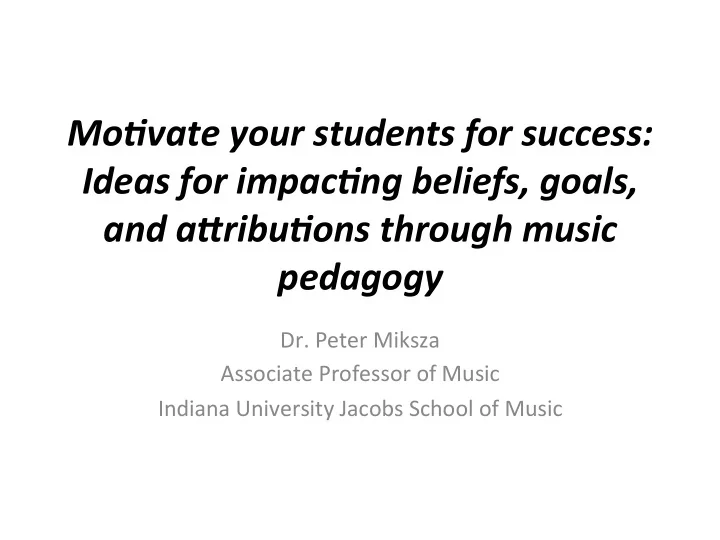

Mo#vate ¡your ¡students ¡for ¡success: ¡ Ideas ¡for ¡impac#ng ¡beliefs, ¡goals, ¡ and ¡a:ribu#ons ¡through ¡music ¡ pedagogy ¡ ¡ Dr. ¡Peter ¡Miksza ¡ Associate ¡Professor ¡of ¡Music ¡ Indiana ¡University ¡Jacobs ¡School ¡of ¡Music ¡
Overview ¡ • The ¡funcAon ¡of ¡moAvaAon ¡theories ¡ • What ¡is ¡moAvaAon? ¡ • The ¡“BIG” ¡picture: ¡Context ¡for ¡how ¡moAvaAon ¡ and ¡learning ¡interact ¡ • The ¡“LESS ¡BIG” ¡picture: ¡Bridging ¡to ¡instrucAon ¡ – A ¡cyclical ¡view ¡of ¡what ¡happens ¡next ¡ – Some ¡common ¡problems ¡with ¡moAvaAon ¡ • Feet ¡on ¡the ¡ground: ¡ApplicaAons ¡and ¡ discussion ¡
¡ THE ¡FUNCTION ¡OF ¡MOTIVATION ¡THEORIES ¡
The ¡funcAon ¡of ¡moAvaAon ¡theories ¡ DISCLAIMER ¡ • No ¡silver ¡bullet ¡ ¡
The ¡funcAon ¡of ¡moAvaAon ¡theories ¡ DISCLAIMER ¡ • GeneraliAes ¡are ¡not ¡subsAtutes ¡for ¡ understanding ¡individuals ¡
The ¡funcAon ¡of ¡moAvaAon ¡theories ¡ • Affect ¡affects ¡behavior ¡ • VariaAons ¡in ¡disposiAon ¡explain ¡and ¡predict ¡ • Focus ¡ – Neurochemical ¡ – Autonomic ¡nervous ¡system ¡ – AutomaAc ¡condiAoned/habitual ¡response ¡ – Personal ¡beliefs ¡ – Social ¡context ¡ – Cultural ¡context ¡
The ¡funcAon ¡of ¡moAvaAon ¡theories ¡ • Human ¡moAvaAon ¡consists ¡of ¡a ¡web ¡of ¡influences ¡ that ¡can ¡vary ¡according ¡to ¡individual ¡development ¡ and ¡experience, ¡social ¡context, ¡and ¡culture ¡
The ¡funcAon ¡of ¡moAvaAon ¡theories ¡ • 109 ¡+ ¡theories ¡
¡ WHAT ¡IS ¡MOTIVATION? ¡
What ¡is ¡moAvaAon? ¡ • Let’s ¡create ¡context… ¡ – Imagine ¡you ¡are ¡someone ¡seeking ¡out ¡specialized ¡ instrucAon ¡as ¡a ¡singer… ¡…you’ve ¡all ¡been ¡there ¡ and/or ¡are ¡there… ¡
What ¡is ¡moAvaAon? ¡ • Choice ¡ • Goals ¡ • Engagement ¡ • Self-‑regulaAon ¡ • Persistence ¡
¡ THE ¡BIG ¡PICTURE ¡
Context ¡for ¡how ¡moAvaAon ¡and ¡ learning ¡interact ¡ • Be`ering ¡ourselves ¡ • Autotelic ¡experience ¡ • Flow ¡
Context ¡for ¡how ¡moAvaAon ¡and ¡ learning ¡interact ¡ • Intrinsic ¡Reasons ¡ – Arising ¡from ¡within ¡an ¡individual ¡ • HumanisAc ¡ideal ¡ – Maslow, ¡Rogers, ¡Seligman ¡ • MoAvaAonal ¡problems ¡ – Unfulfilled ¡needs ¡ – Disparity ¡between ¡who ¡we ¡are ¡and ¡want ¡to ¡be ¡ – Feel ¡controlled ¡or ¡disconnected ¡from ¡the ¡purpose ¡of ¡our ¡ acAviAes ¡
Context ¡for ¡how ¡moAvaAon ¡and ¡ learning ¡interact ¡ • Maslow’s ¡hierarchy ¡of ¡needs ¡ – Self-‑actualizaAon ¡– ¡a ¡growth ¡need, ¡something ¡we ¡ strive ¡for ¡to ¡pursue ¡personal ¡growth ¡and ¡ fulfillment ¡ – Barriers ¡to ¡self-‑actualizaAon ¡– ¡deficiency ¡needs, ¡ physiological ¡sustenance, ¡safety, ¡belongingness, ¡ esteem ¡
Context ¡for ¡how ¡moAvaAon ¡and ¡ learning ¡interact ¡ • Maslow’s ¡hierarchy ¡of ¡needs ¡
Context ¡for ¡how ¡moAvaAon ¡and ¡ learning ¡interact ¡ • Self-‑determinaAon ¡ – “The ¡process ¡of ¡uAlizing ¡one’s ¡will” ¡(Deci, ¡1980, ¡p. ¡ 26) ¡ – Autonomy ¡ – Competence ¡ – Relatedness ¡
Context ¡for ¡how ¡moAvaAon ¡and ¡ learning ¡interact ¡ • SDT ¡ – People ¡work ¡to ¡grow, ¡experience ¡mastery, ¡and ¡ integrate ¡new ¡experiences ¡into ¡a ¡sense ¡of ¡their ¡self ¡ – Autonomy ¡ • A ¡need ¡to ¡feel ¡free ¡to ¡guide ¡one’s ¡own ¡life ¡and ¡make ¡choices ¡ (not ¡isolaAon ¡or ¡disconnectedness) ¡ – Competence ¡ • A ¡belief ¡that ¡one ¡can ¡deal ¡effecAvely ¡with ¡their ¡environment ¡ – Relatedness ¡ • A ¡need ¡to ¡feel ¡socially ¡connected, ¡loved, ¡and ¡respected ¡
Context ¡for ¡how ¡moAvaAon ¡and ¡ learning ¡interact ¡ • Social ¡contexts ¡can ¡support ¡or ¡thwart ¡ – Support ¡ • Balancing ¡structure/scaffolding ¡and ¡independent ¡work/ decision ¡making ¡is ¡important ¡ • Giving ¡opportuniAes ¡to ¡make ¡choices ¡vs. ¡emphasizing ¡ interpersonal ¡control ¡ • Providing ¡informaAonal ¡instrucAon ¡(ways ¡to ¡achieve ¡ objecAve) ¡vs. ¡controlling ¡rules ¡(specific ¡ways ¡to ¡do ¡ things) ¡ • CommunicaAng ¡evaluaAons ¡to ¡improve ¡what ¡they’re ¡ doing ¡vs. ¡as ¡how ¡they ¡‘should’ ¡perform ¡
Context ¡for ¡how ¡moAvaAon ¡and ¡ learning ¡interact ¡ • Social ¡contexts ¡can ¡thwart ¡ – Undermine ¡self-‑determinaAon ¡via ¡extrinsic ¡ rewards ¡(especially ¡if ¡they’re ¡already ¡intrinsically ¡ moAvated) ¡ – Reinforcing ¡links ¡between ¡self-‑esteem ¡and ¡ conAngent ¡rewards ¡ – Overemphasize ¡high ¡stakes ¡achievement ¡and ¡peer ¡ comparison ¡to ¡the ¡point ¡of ¡anxiety ¡or ¡amoAvaAon ¡ – Lack ¡of ¡opportuniAes ¡to ¡feel ¡as ¡part ¡of ¡a ¡ community ¡of ¡learners ¡
Context ¡for ¡how ¡moAvaAon ¡and ¡ learning ¡interact ¡ • Social ¡contexts ¡can ¡also ¡impact ¡how ¡and ¡ whether ¡people ¡integrate ¡the ¡values ¡of ¡their ¡ environment ¡within ¡themselves ¡
Context ¡for ¡how ¡moAvaAon ¡and ¡ learning ¡interact ¡ • IntegraAng ¡ – Help ¡students ¡value ¡the ¡acAvity, ¡feel ¡competent ¡to ¡do ¡it, ¡ and ¡acquire ¡beliefs ¡that ¡they ¡will ¡be ¡able ¡to ¡do ¡it ¡well ¡ – Model ¡behaviors ¡through ¡significant ¡others ¡that ¡student ¡ would ¡like ¡to ¡feel ¡connected ¡to ¡– ¡peers, ¡teachers, ¡role ¡ models, ¡heroes ¡ – Show ¡there ¡is ¡value ¡in ¡the ¡behavior ¡as ¡recognized ¡by ¡their ¡ social ¡group ¡ – Be ¡sure ¡to ¡prepare ¡students ¡for ¡the ¡experience ¡and ¡give ¡ them ¡a ¡sense ¡of ¡readiness ¡to ¡be ¡competent ¡ – Try ¡to ¡make ¡connecAons ¡to ¡the ¡student’s ¡other ¡goals ¡and ¡ values ¡to ¡increase ¡autonomy ¡
Context ¡for ¡how ¡moAvaAon ¡and ¡ learning ¡interact ¡ • Summary ¡of ¡the ¡context ¡ – Aiming ¡for ¡“becoming” ¡for ¡self-‑fulfillment ¡ – Desiring ¡flow ¡ – Autonomy, ¡competence, ¡and ¡relatedness ¡ – Necessary ¡to ¡support ¡these ¡essenAal ¡needs ¡ through ¡instrucAonal ¡design ¡(e.g., ¡social ¡context) ¡ – It’s ¡possible ¡to ¡help ¡students ¡internalize ¡new ¡ values ¡and ¡develop ¡intrinsic ¡moAvaAon ¡for ¡things ¡ they ¡are ¡iniAally ¡not ¡interested ¡in ¡or ¡defiant ¡about ¡
¡ THE ¡LESS ¡BIG ¡PICTURE ¡ ¡ Bridging ¡to ¡instruc-on ¡
Bridging ¡to ¡instrucAon ¡ • Preview ¡ – A ¡cyclical ¡set ¡of ¡concepts ¡ • Mindset ¡ • Self-‑efficacy ¡ • Achievement ¡goal ¡orientaAon ¡ • A`ribuAons ¡ – Problems ¡
Bridging ¡to ¡instrucAon ¡ • Mindset ¡as ¡a ¡first ¡step ¡(Dweck) ¡ – Fixed ¡(enAty) ¡vs. ¡Growth ¡(incremental) ¡ – Choice ¡to ¡pursue ¡music, ¡the ¡goals ¡you ¡set, ¡ expectaAons ¡of ¡success ¡
Recommend
More recommend